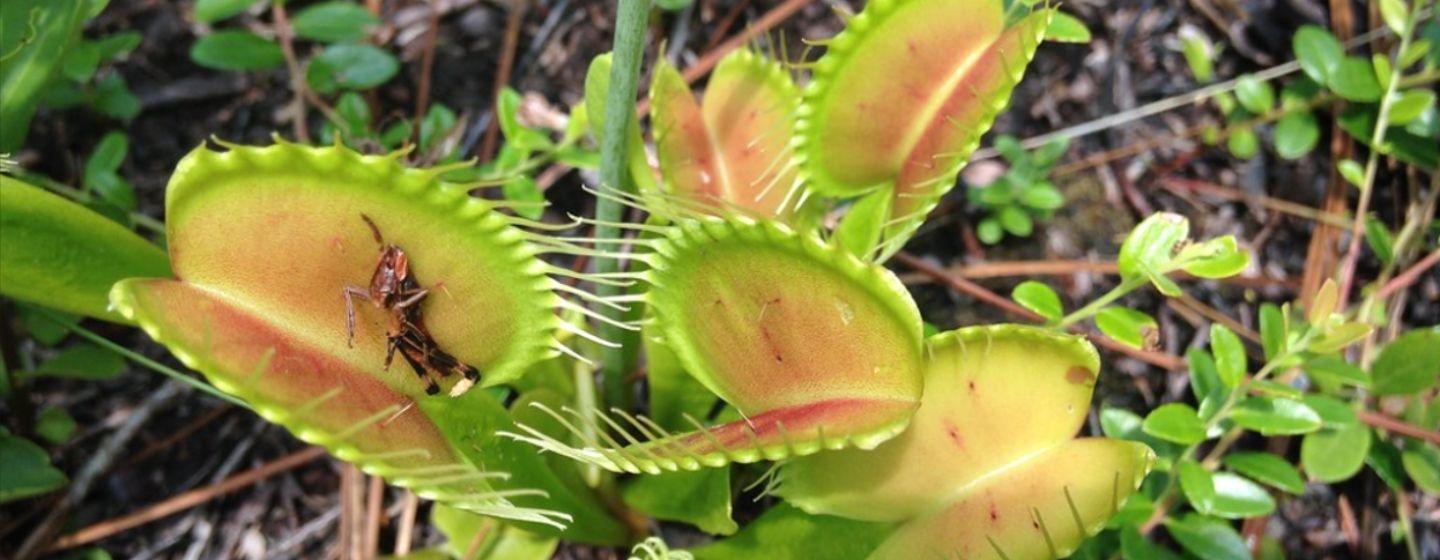The Venus Flytrap Inhabits a Small Area, but It’s Not Endangered


The Venus flytrap is a Broadway star (think Little Shop of Horrors). It’s appeared in various forms in the backgrounds of many dinosaur/prehistoric/alien-planet types of movies.
Charles Darwin once called it “one of the most wonderful plants in the world” in a book written in 1875. That’s high praise!
And to be honest, what’s not to love about a carnivorous plant with an amazing way to get nourishment? The Venus flytrap ensnares insects within its toothlike, snap-trap leaves, which are triggered to close when unsuspecting prey lands inside one of the plant’s small, kidney-shaped lobes. Once the insect touches the small hairs in the trap that act like sensors, the leaves snap shut around it within milliseconds.
That ability makes the Venus flytrap a celebrity in the plant world. But the reality is that they are hard to spot in the wild because they are small.
Plus, the plant lives in just a few select places, all found on the coastal plains of North and South Carolina within about 100 miles of Wilmington.
Why? Because the Venus flytrap needs open, sunny, nutrient-poor, wet habitats. Those areas are generally found in longleaf pine wetland forests and along small creeks with shrubs in the Sandhills and the coastal plain.
Here’s the other thing. Venus flytraps need areas where fires are allowed to burn rather than put out. That keeps the small trees and shrubs from growing too tall and blocking out the sun.
Because of the Venus flytrap’s limited habitat, botanists and conservationists petitioned the U.S. Fish and Wildlife Service to list the Venus flytrap as federally endangered in 2016. The International Union for the Conservation of Nature (IUCN) listed the plant as “vulnerable” in 2020.
But the federal agency turned down the request in July 2023.
“Based on a review of the best available science, it was determined the carnivorous plant is not facing imminent threat of extinction now or in the foreseeable future and therefore does not warrant listing under the Endangered Species Act,” the agency said in a news release. That means the agency decided not to list it as threatened or endangered. The agency points to eight locations with populations they believe are stable, protected and well managed.
The agency says those locations, plus the fact the Venus flytrap is protected under North Carolina laws, should be enough to sustain the species and avoid the need for federal protection. It’s a felony in North Carolina to take a Venus flytrap from the wild.
At least 75% of all the wild plants are found in large populations on Marine Corps Base Camp Lejeune, North Carolina State Game Lands, the Green Swamp (a preserve owned and managed by The Nature Conservancy) and the Lewis Ocean Bay Heritage Preserve in South Carolina. Smaller populations are found in properties owned by the North Carolina Plant Conservation Program.
“Habitat protection and management, abundant partner involvement, academic research and data from a new status survey helped inform these findings,” said Mike Oetker, deputy regional director of the U.S. Fish and Wildlife Service’s Southeast Region, in a release from USFWS. “With healthy population, projections indicate it can thrive under current conditions well into the future.”
The USFWS lists the main threats to Venus flytraps as development and fire suppression. Some scientists fear rapid sea level rise, fueled by climate change, could change the soils on the coastal plain.
To learn more about the Venus flytrap, check out this story from PBS North Carolina’s Seasonal Science collection.